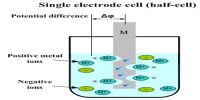In heterogeneous systems where two or more phases are present at equilibrium (e.g. solid and gas), the equilibrium is unaffected by the amounts of pure solids or pure liquids present, as long as some of each is present. This is because the concentrations of solids and liquids are constant.
For example, [H2O (I)] = density/RMM = 1000 g dm-3/ 18 g mol-1 = 55.56 mol.dm-3. In a heterogeneous system [H2O] is always this value and has been included in the rate constant.
Consider the following equilibrium law:
H2O (g) + C (s) = H2 (g) + CO (g)
The equilibrium constant expression is adapted to include this constant term in the following Kc value:
Kc = [H2] x [CO] / [H2O]
Exercise
What would be the expression for the equilibrium constant for the following reactions?
Cu (s) + 2Ag+ (aq) = Cu2+ (aq) + Ag (s)
Fe3 O4 (s) + 4H2 (g) ↔ 3Fe (s) + 4H2O (g)














